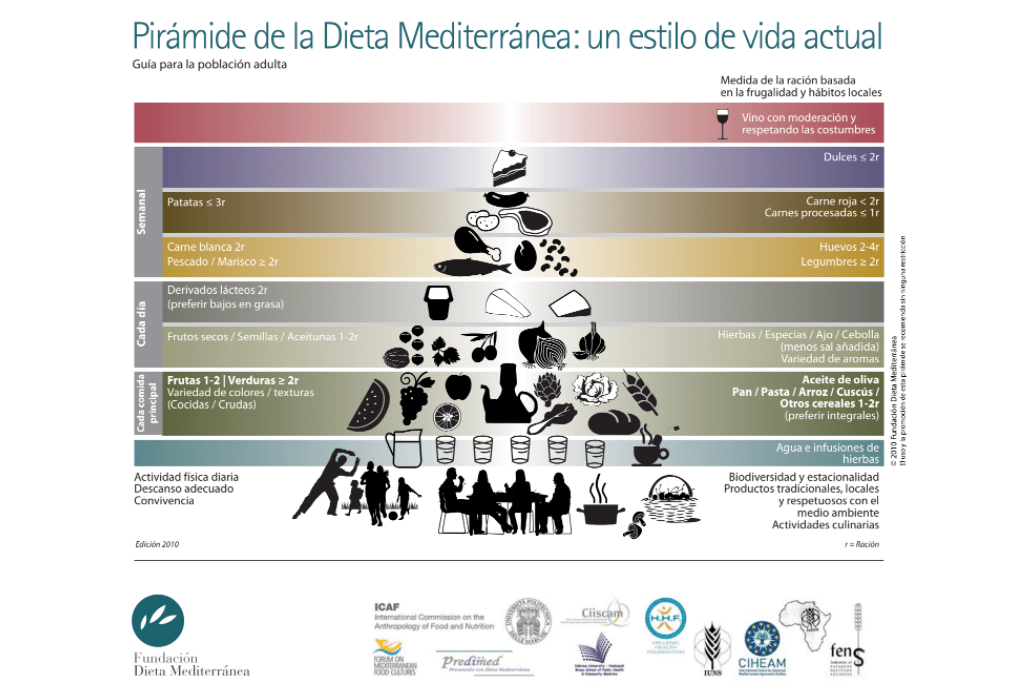Published in Public Health Nutrition: 14(12A), 2274–2284.
Anna Bach-Faig, Elliot M Berry, Denis Lairon, Joan Reguant, Antonia Trichopoulou, Sandro Dernini, F Xavier Medina, Maurizio Battino, Rekia Belahsen, Gemma Miranda and Luis Serra-Majem, on behalf of the Mediterranean Diet Foundation Expert Group, Mediterranean Diet Foundation, Barcelona, Spain: Department of Human Nutrition and Metabolism, Braun School of Public Health, Hebrew University-Hadassah Medical School, Jerusalem, Israel: Research Unit 1025 Inserm/1260 Inra/‘‘Human Nutrition and Lipids: Bioavailability, Metabolism and Regulations’’, Faculte de Medecine, Universite de la Mediterranee, Marseille, France: Hellenic Health Foundation, Athens, Greece: Forum on Mediterranean Food Cultures, Rome, Italy: Interuniversity International Center for Mediterranean Food Cultures Studies (CIISCAM), Sapienza University of Rome, Italy: Department of Food Systems,
Culture and Society, Faculty of Health Sciences, Universitat Oberta de Catalunya (UOC), Barcelona, Spain: Department of Biochemistry, Universita` Politecnica delle Marche, Ancona, Italy: Department of Biology, Faculty of Sciences, Chouaı Doukkali University, El Jadida, Morocco: Department of Clinical Sciences, University of Las Palmas de Gran Canaria, PO Box 550, 35080, Las Palmas de Gran Canaria, Spain
Objective: To present the Mediterranean diet (MD) pyramid: a lifestyle for today.
Design: A new graphic representation has been conceived as a simplified main frame to be adapted to the different nutritional and socio-economic contexts of the Mediterranean region. This review gathers updated recommendations considering the lifestyle, dietary, sociocultural, environmental and health challenges that the current Mediterranean populations are facing.
Setting and Subjects: Mediterranean region and its populations.
Results: Many innovations have arisen since previous graphical representations of the MD. First, the concept of composition of the ‘main meals’ is introduced to reinforce the plant-based core of the dietary pattern. Second, frugality and moderation is emphasized because of the major public health challenge of obesity. Third, qualitative cultural and lifestyle elements are taken into account, such as conviviality, culinary activities, physical activity and adequate rest, along with proportion and frequency recommendations of food consumption.
These innovations are made without omitting other items associated with the production, selection, processing and consumption of foods, such as seasonality, biodiversity, and traditional, local and eco-friendly products.
Conclusions: Adopting a healthy lifestyle and preserving cultural elements should be considered in order to acquire all the benefits from the MD and preserve this cultural heritage. Considering the acknowledgment of the MD as an Intangible Cultural Heritage of Humanity by UNESCO (2010), and taking into account its contribution to health and general well-being, we hope to contribute to a much better adherence to this healthy dietary pattern and its way of life with this new graphic representation.
Read the full paper here.

